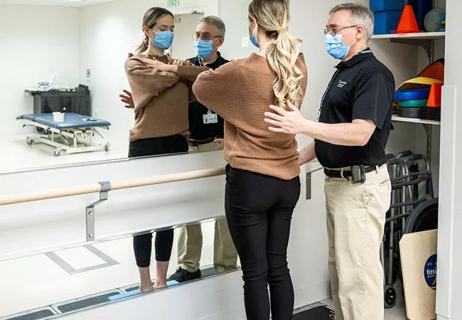Recommendations look to change mindset with CI referrals

Cochlear implants (CI) have been available for more than 40 years, yet many providers still consider them a treatment of last resort for patients with hearing loss. As a result, experts estimate that as few as 2% of patients who could benefit from cochlear implants receive them. Now, new clinical guidelines aim to improve access to this sense-restoring procedure.
Advertisement
Cleveland Clinic is a non-profit academic medical center. Advertising on our site helps support our mission. We do not endorse non-Cleveland Clinic products or services. Policy
The guidelines, released by the American Cochlear Implant Alliance, include 13 key recommendations that include referring a larger segment of patients for evaluation, expanding the criteria for referral, and considering hearing loss in each ear individually, notes Sarah Sydlowski, AuD, PhD, MBA, Associate Chief Improvement Officer and Audiology Director of the Hearing Implant Program at Cleveland Clinic, and co-author of the paper.
“We’re missing the vast majority of people who could benefit from this technology,” she says. “Part of the reason is that everyone does this differently, and many people are still far too conservative.”
The paper, “American Cochlear Implant Alliance Task Force: Recommendations for Determining Cochlear Implant Candidacy in Adults,” was published in The Laryngoscope. The guidelines were formally adopted by the ACIA before publication and have been endorsed by the American Academy of Audiology.
When cochlear implants were first developed, they were considered an emerging technology and were used primarily as a last resort for patients for whom hearing aids were no longer effective. Decades of research since then has shown that patients have better outcomes when they receive implants sooner and that waiting can reduce benefits.
“Many primary care physicians (PCPs) are not aware of these developments, and even audiologists have used different approaches when determining a patient’s candidacy,” she explains. “There’s a lot of variation, and that variation equates to missed patients,”
Advertisement
While the American Academy of Audiology has issued clinical practice guidelines for the management of cochlear implant patients, no similar guidelines existed for the identification of candidates, Dr. Sydlowski notes.
For the new guidelines, members of the task force reviewed existing literature and created a consensus document for best practices around identifying and referring potential candidates.
Dr. Sydlowski says one of the most important recommendations is that cochlear implants should not be considered a last resort. “Just because someone has residual natural hearing or still has some benefit from hearing aids does not exclude them from being an implant candidate, and the earlier we can identify these candidates the better,” she explains.
Instead, Dr. Sydlowski suggests that if an evaluation shows a patient is understanding fewer than 50% of words while wearing hearing aids, they should be considered for cochlear implantation.
In another big shift, the guidelines call for providers to consider each ear individually, rather than focusing on the patient’s overall hearing. She notes that implant technology can now be used to optimize hearing in a single ear, offering benefits to patients with single-sided deafness, as well as asymmetric hearing loss where one ear may be worse than the other.
In addition to significantly improving word recognition, cochlear implants have been shown to improve subjective factors like quality of life, reduce symptoms of tinnitus, and decrease the patient’s perception that hearing loss impacts their ability to function in daily life.
Advertisement
The task force acknowledged that one thing holding providers back from referring patients for evaluation earlier is the perception that the patient will believe they are a candidate and be disappointed if they don’t qualify, or that the audiologists will be annoyed if they frequently refer patients who are not candidates.
“Referring physicians tend to wait until they were sure, because they don’t want to make a bad referral,” she explains. “What we are saying is that there is no bad CI referral.”
Even if the patient doesn’t initially qualify for implants, the audiologist can do more comprehensive testing to understand their hearing limitations, discuss their options, and establish a baseline to measure against future hearing loss, she notes.
Dr. Sydlowski stresses that PCPs have an important role to play in identifying and referring patients for evaluation. PCPs should ask patients about their hearing as part of routine check-ups and help them understand that hearing is a critical part of health. Patients over 50 should be referred to an audiologist for a hearing test, and providers should encourage their patients to use appropriate hearing technology as soon as it’s recommended.
Several studies show a correlation between unmanaged hearing loss and cognitive decline, she notes, and emerging data suggests that treating hearing loss appropriately can mitigate those risks.
However, Dr. Sydlowski believes many patients — and providers — have the mindset that hearing loss is simply a normal, and unavoidable, part of aging.
Advertisement
“That’s not the case,” she says. “It might be common, but it’s not normal. This is a health condition that needs to be managed and can be managed very successfully.”
Advertisement
Advertisement

Study shows no negative impact for individuals with better contralateral ear performance

Expanded patient criteria and surgical advances mean more patients can benefit

Research on children with UHL explores the quality-of-life benefits and outcomes of cochlear implants

When a patient failed to improve, the value of a comprehensive vestibular test was apparent

Case study illustrates the potential of a dual-subspecialist approach

Evidence-based recommendations for balancing cancer control with quality of life

HNS device offers new solution for those struggling with CPAP

Patient with cerebral palsy undergoes life-saving tumor resection